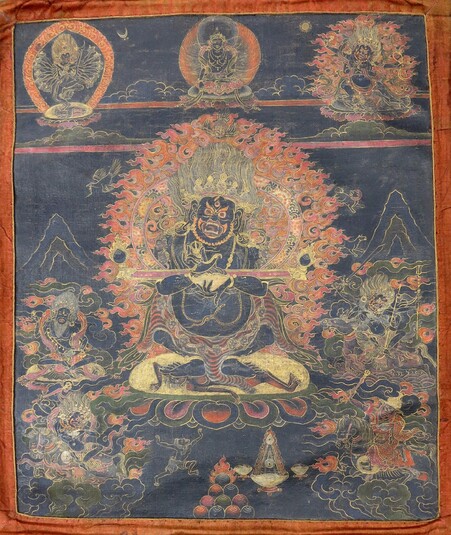
Item: Mahakala (Buddhist Protector) - Panjarnata (Lord of the Pavilion)
| Origin Location | Tibet |
|---|---|
| Date Range | 1700 - 1799 |
| Lineages | Sakya and Buddhist |
| Material | Ground Mineral Pigment, Black Background on Cotton |
| Collection | Private |
Mahakala, Vajra Panjarnata (Tibetan: dor je gur gyi gon po. English: the Great Black One, Lord of the Vajra Pavilion [or Canopy]): from the Vajra Panjara Tantra.
Fiercely wrathful, black in colour with one face, large round eyes, flaming yellow hair and two hands he holds a curved knife in the right and a skullcup in the left - both held to the heart. Resting across the forearms is a 'gandhi' stick from which all other forms of Mahakala emanate. Adorned with a crown of five dry skulls, bone ornaments and a necklace of fifty freshly severed heads he wears a lower garment of tiger skin. Atop a corpse, circular disc of the sun and multi-coloured lotus he stands surrounded by the flames of pristine awareness.
At the top center is Akshobhya Buddha. On the left is Shri Hevajra and on the right Bhutadamara Vajrapani. At the middle left is Brahmanarupa Mahakala and on the right Shri Devi Dudsolma. At the bottom left is Shri Devi Magzor Gyalmo and on the right Dorje Shugden Tanag (Riding a Black Horse).
The translation of the description of Panjara Mahakala below is from the Rinchen Zangpo Tradition. It is identical to the description of the Vajrapanjara Tantra Mahakala except for the inclusion of the 'gandhi' stick.
"The Great Vajra Mahakala, blazing, with one face, two hands, in the right a curved knife and left a skullcup filled with blood, held above and below the heart. Held across the middle of the two arms is the 'Gandhi of Emanation;' with three eyes, bared fangs, yellow hair flowing upward, a crown of five dry human skulls and a necklace of fifty fresh, blood-dripping. [He is] adorned with six bone ornaments and snakes, with a lower garment of tiger skin, flowing with pennants and streamers of various silks; dwarfish and thick, in a posture standing above a corpse." (Konchog Lhundrub, 1497-1557).
The general features that describe and define Panjarnata are the single face and two arms. The pair of hands hold a curved knife in the right and a skull cup in the left. Both hands are held to the heart with the right hand slightly above the skull cup. Panjara may or may not also have a 'gandhi' stick across the forearms. His body is short and squat with the legs bowed. He is also described as being a dwarf with short thick arms and legs. He typically stands atop a human corpse having an orange or yellow colour. All of the other characteristics of Panjarnata are identical with the general characteristics of the Mahakala class of deities.
Panjaranatha Mahakala arises from the Panjara (Pavilion, or canopy) Tantra for which he is the protector and guardian. This Tantra belongs to the Hevajra Cycle of Tantras and classified as Non-dual Anuttarayoga. The method of painting is 'nag thang,' black scroll - gold outline on a black background with a lack of superfluous ornamentation and landscape.
Jeff Watt 7-2012
Numbered Image: 1. Panjarnata Mahakala 2. Akshobhya Buddha 3. Shri Hevajra 4. Bhutadamara Vajrapani 5. Brahmanarupa Mahakala 6. Shri Devi Dudsolma 7. Shri Devi Magzor Gyalmo 8. Dorje Shugden Tanag (Riding a Black Horse)
Front of Painting
English Translation of Inscription: [No inscriptions]
Reverse of Painting
English Translation of Inscription: [No inscriptions]
Mahakala: Panjarnata, Lord of the Pavilion (Main Page)
Collection of WGA
Buddhist Deity: Dorje Shugden Tanag (Minor Figure)


